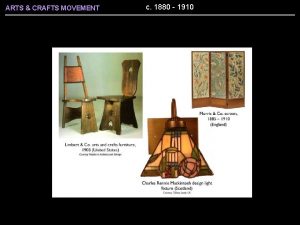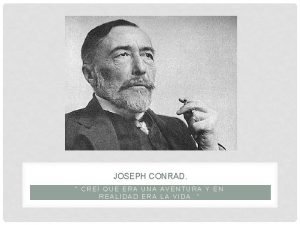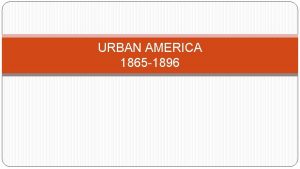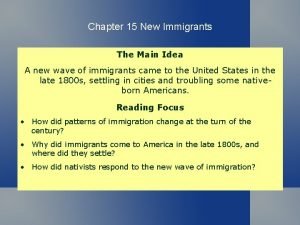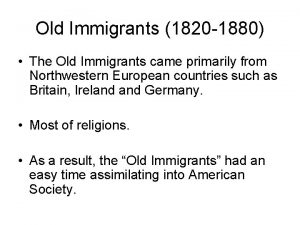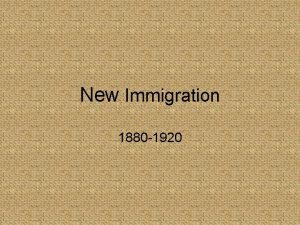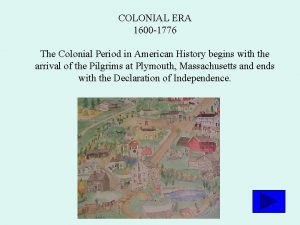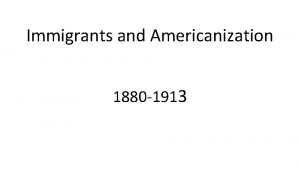From the colonial era to 1880 most immigrants
















- Slides: 16

From the colonial era to 1880, most immigrants came from England, Ireland, or Germany in Northern Europe The “new immigrants” were typically young, male, either Catholic or Jewish, and spoke little or no English The majority were unskilled agricultural laborers with little money or education Between 1880 and 1921, 70% of all immigrants to the USA came from southern and eastern Europe (Italy, Poland, Austria-Hungary, Russia)

75% of all immigrants entered the USA through the immigration center at Ellis Island, in New York Immigrants had to pass Inspectors questioned a health examination immigrants to made sure and anyone with a that they were not serious health problem criminals, could work, and or disease was not let in had some money ($25)

Many Americans expressed nativism and viewed immigrants with a sense of fear, suspicion, and hostility Nativists had deepseated prejudices about immigrants based on ethnicity, religion, political and social beliefs Many Americans accused immigrants of taking jobs away from “real” Americans and called for quotas that would limit the number of immigrants

The Gilded Age experienced massive urbanization In 1850, only 15% of City growth was due to Americans lived in cities… rural Americans moving to cities and immigrants …By 1900, 40% of entering the USA Americans lived in cities

Engineering innovations, such as expansive bridges and skyscrapers, led to modern American cities Cities expanded outward from industrial centers in the central business districts to a ring of outer suburbs As cities grew larger and beyond walking distance, trolley lines, elevated rail lines, and subways were created

Most American cities were not prepared for such rapid population growth Most urban immigrants lived in tenements: low rent apartments built the poorest parts of town called slums Many urban poor developed lung disease or tuberculosis; About 60% of immigrant babies died before their first birthday

About 2/3 of immigrants settled in cities, such as New York, Chicago, Boston, or Philadelphia and lived in ethnic neighborhoods called enclaves Enclaves provided new immigrants with a sense of community and security, as the immigrants were surrounded by the familiar customs, food and language of their homeland

The majority of immigrants worked in industrial jobs Industries were rapidly growing and in need of cheap workers Most immigrants were unskilled and were willing to accept almost any kind of job, no matter how un-attractive or low paying

In response to the low wages, long hours, and dangerous working conditions, many workers joined labor unions to collectively bargain for improvements

Among the first labor unions in America was the Knights of Labor The Knights of Labor was open to all workers regardless of race, gender, or skill

The most successful union was the American Federation of Labor (AFL) led by Samuel Gompers The AFL only included skilled workers, but it used collective bargaining to gain better pay, shorter hours, and better working conditions for its union members Most workers were unskilled and ineligible to join the AFL

By the end of the Gilded Age, only 4% of all American workers were unionized

One of the tactics used by unions was to strike: Strikes were designed to stop production in order to force management to accept union demands Business leaders resisted strikes by hiring replacement workers or private police to break up strikes During some strikes, violence broke out

During the Chicago Haymarket Strike (1886), unionists demanded an 8 -hr day; When violence broke out, public opinion turned against unions, viewing them as violent and “un-American”

Violence erupted in the Homestead Strike (1892) at Carnegie’s steel plant; Federal troops were called to re-open the factory with replacement workers

Railroad workers led a national strike when the Pullman Palace Company cut wages by 50%. . . …President Cleveland sent the army to end the strike; Strikers in 27 states resisted & dozens died
 Old immigrants vs new immigrants
Old immigrants vs new immigrants Where did most of the irish immigrants settle
Where did most of the irish immigrants settle Ethos pathos logos jeopardy
Ethos pathos logos jeopardy In the colonial era developments such as the new england
In the colonial era developments such as the new england Latviešu dzejnieks 1880
Latviešu dzejnieks 1880 Whitechapel 1880s
Whitechapel 1880s After 1880 european nations sought
After 1880 european nations sought Johnny's lunches is considering purchasing a new
Johnny's lunches is considering purchasing a new Arts and crafts movement 1880 to 1910
Arts and crafts movement 1880 to 1910 Creí que era una aventura y en realidad era la vida
Creí que era una aventura y en realidad era la vida Vi uma estrela tão alta
Vi uma estrela tão alta Era quiz: the baroque era
Era quiz: the baroque era Victorian era vs elizabethan era
Victorian era vs elizabethan era Gilded age westward expansion
Gilded age westward expansion Europeans
Europeans Chapter 15 section 1 the new immigrants
Chapter 15 section 1 the new immigrants Chapter 15 immigrants and urbanization
Chapter 15 immigrants and urbanization








